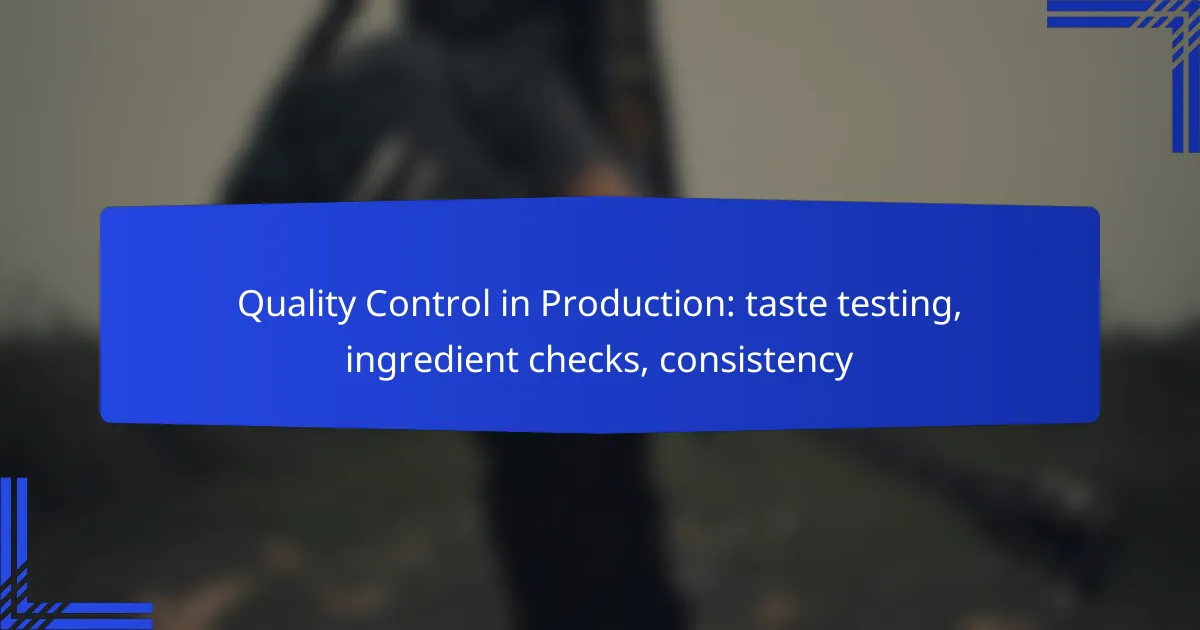Quality control in production is essential for delivering products that meet consumer expectations and safety standards. This involves rigorous taste testing to evaluate flavor and aroma, thorough ingredient checks to verify the quality of raw materials, and structured methods to ensure consistency across batches. By implementing these practices, manufacturers can maintain high-quality standards and foster consumer trust.

What are effective taste testing methods in Australia?
Effective taste testing methods in Australia include various sensory evaluation techniques that assess flavor, aroma, and overall quality. These methods help ensure that food products meet consumer expectations and regulatory standards.
Descriptive sensory analysis
Descriptive sensory analysis involves trained panels that evaluate specific attributes of a product, such as taste, texture, and aroma. This method provides detailed feedback on how a product is perceived, allowing producers to make informed adjustments. It is crucial to ensure that panelists are properly trained to maintain consistency and reliability in their assessments.
In Australia, this method is often used in conjunction with standardized protocols to ensure that results are comparable across different products and batches. This can include using a structured vocabulary to describe sensory attributes.
Triangle testing
Triangle testing is a discrimination test where participants are presented with three samples: two are identical, and one is different. The goal is to identify the odd sample. This method is effective for detecting subtle differences in products, such as variations in flavor or texture due to ingredient changes or processing methods.
In practice, triangle tests are straightforward to conduct and can yield quick results. However, it is essential to have a sufficient number of participants to ensure statistical validity, typically ranging from 20 to 30 testers.
Consumer preference testing
Consumer preference testing gauges how well a product meets the tastes and preferences of the target market. This method typically involves surveys or taste panels where consumers rate products based on their liking or preference. It provides valuable insights into market acceptance and potential sales performance.
When conducting consumer preference tests in Australia, it is important to consider demographic factors such as age, gender, and cultural background, as these can significantly influence taste preferences. A well-designed test can help identify the most appealing product formulations for specific consumer segments.

How to conduct ingredient checks in production?
Conducting ingredient checks in production involves verifying the quality and specifications of raw materials before they are used. This process ensures that the final product meets safety standards and maintains consistent quality.
Supplier audits
Supplier audits are essential for assessing the reliability and quality control processes of ingredient providers. During an audit, you should evaluate the supplier’s facilities, quality management systems, and compliance with relevant regulations.
Consider establishing a checklist that includes aspects like documentation accuracy, ingredient traceability, and adherence to safety standards. Regular audits can help identify potential issues before they affect production.
Batch sampling
Batch sampling involves taking representative samples from production batches to test for quality and consistency. This method allows you to detect variations in ingredients or processes that could impact the final product.
Implement a sampling plan that specifies the number of samples to be taken and the frequency of testing. For instance, sampling every 1000 kg of a bulk ingredient can help ensure that quality remains within acceptable limits.
Laboratory analysis
Laboratory analysis is crucial for verifying the chemical and physical properties of ingredients. Testing can include checks for contaminants, nutritional content, and compliance with specifications.
Utilize accredited laboratories to perform tests that align with industry standards. Regular analysis can help maintain product integrity and provide documentation for regulatory compliance, particularly in food production sectors.

What are the best practices for ensuring consistency?
Ensuring consistency in production involves implementing structured methods and technologies to maintain uniform quality across products. Best practices include establishing standard operating procedures, utilizing automated quality control systems, and regularly calibrating equipment.
Standard operating procedures
Standard operating procedures (SOPs) are essential for maintaining consistency in production. They provide clear guidelines on how tasks should be performed, ensuring that every team member follows the same processes. This minimizes variations in production quality.
When developing SOPs, involve key stakeholders to capture all necessary details. Regularly review and update these procedures to reflect any changes in processes or regulations, ensuring they remain relevant and effective.
Automated quality control systems
Automated quality control systems enhance consistency by using technology to monitor production processes in real-time. These systems can detect deviations from set quality standards, allowing for immediate corrective actions. This reduces human error and increases efficiency.
Consider integrating sensors and software that can analyze data on product quality metrics, such as taste, texture, and ingredient composition. This data-driven approach helps maintain high standards and can lead to significant cost savings over time.
Regular calibration of equipment
Regular calibration of equipment is crucial for ensuring consistent production quality. Calibration verifies that machines and instruments are functioning correctly and producing accurate measurements. Neglecting this can lead to significant quality issues and increased waste.
Establish a routine calibration schedule based on manufacturer recommendations and production demands. Document all calibration activities to maintain compliance with industry standards and facilitate audits. This practice helps in identifying potential equipment failures before they impact production.

What are the regulatory requirements for quality control in Australia?
In Australia, quality control in production is governed by various regulatory requirements that ensure food safety and product consistency. Key regulations include adherence to national food safety standards and specific industry guidelines that dictate quality assurance practices.
Food Standards Australia New Zealand (FSANZ) guidelines
FSANZ provides a framework for food safety and quality in Australia, outlining standards that food businesses must follow. These guidelines cover aspects such as ingredient sourcing, processing methods, and labeling requirements to ensure consumer safety and product integrity.
Businesses should regularly review FSANZ standards, which are updated to reflect new research and safety concerns. Compliance helps maintain high product quality and protects public health, making it essential for producers to stay informed about any changes.
Compliance with HACCP principles
HACCP (Hazard Analysis and Critical Control Points) is a systematic approach to food safety that identifies potential hazards and establishes control measures. In Australia, compliance with HACCP principles is often mandatory for food production facilities, ensuring that risks are managed effectively throughout the production process.
To implement HACCP, businesses should conduct a thorough hazard analysis, establish critical control points, and monitor these points regularly. This proactive approach not only enhances product quality but also builds consumer trust in the brand.

How does technology enhance quality control in production?
Technology significantly enhances quality control in production by automating processes and providing real-time data analysis. This leads to improved accuracy in taste testing, ingredient checks, and consistency across batches.
Use of AI in quality assessment
AI plays a crucial role in quality assessment by analyzing data from various production stages. Machine learning algorithms can identify patterns in taste profiles, detect anomalies, and predict potential quality issues before they arise.
For example, AI systems can evaluate sensory data from taste tests, ensuring that products meet predefined flavor profiles. This not only speeds up the assessment process but also reduces human error, leading to more consistent product quality.
Blockchain for ingredient traceability
Blockchain technology enhances ingredient traceability by providing a secure and transparent ledger of all ingredients used in production. This ensures that every component can be traced back to its source, which is crucial for quality assurance and compliance with safety regulations.
By implementing blockchain, companies can quickly verify the origin of ingredients, monitor their journey through the supply chain, and respond effectively to any quality concerns. This transparency builds consumer trust and can help mitigate risks associated with ingredient recalls.

What are the challenges in maintaining quality control?
Maintaining quality control in production involves several challenges, including variability in the supply chain and human error during testing. These factors can significantly impact the consistency and reliability of the final product.
Supply chain variability
Supply chain variability can lead to inconsistencies in the quality of raw materials, which directly affects the production process. Factors such as supplier reliability, transportation delays, and fluctuations in ingredient availability can disrupt the expected quality standards.
To mitigate these issues, companies should establish strong relationships with suppliers and implement regular quality audits. Additionally, diversifying suppliers can help reduce dependency on a single source, ensuring a more stable supply of high-quality ingredients.
Human error in testing
Human error during testing can compromise the accuracy of quality control measures. Mistakes in measurement, misinterpretation of results, or inconsistent testing procedures can lead to faulty conclusions about product quality.
To minimize human error, training staff on standardized testing protocols is essential. Implementing automated testing systems can also enhance accuracy and reduce reliance on manual processes, thereby improving overall quality control.

What emerging trends are shaping quality control in production?
Emerging trends in quality control focus on enhancing efficiency and accuracy through technology and data-driven approaches. Innovations such as automation, real-time monitoring, and artificial intelligence are increasingly being integrated into quality assurance processes.
Taste Testing
Taste testing remains a critical component of quality control in food production. It involves evaluating the flavor, aroma, and texture of products to ensure they meet established standards and consumer expectations. Regular taste panels can help identify variations and maintain consistency across batches.
To implement effective taste testing, companies should establish a standardized protocol that includes a diverse panel of tasters, clear evaluation criteria, and a controlled environment. This helps minimize bias and ensures reliable results.
Ingredient Checks
Ingredient checks are essential for maintaining product quality and safety. This process involves verifying the quality, freshness, and compliance of raw materials before they enter production. Regular audits and supplier assessments can help ensure that ingredients meet required specifications.
Companies should consider implementing a traceability system to track ingredients from source to final product. This not only aids in quality assurance but also enhances transparency and accountability in the supply chain.
Consistency
Consistency in production is vital for building consumer trust and brand loyalty. It involves ensuring that each batch of product meets the same quality standards in terms of taste, appearance, and texture. Variability can arise from numerous factors, including ingredient quality and production methods.
To achieve consistency, manufacturers should invest in process control technologies, such as automated mixing and temperature regulation systems. Regular training for staff on quality standards and procedures can also help minimize human error and maintain uniformity across production runs.
